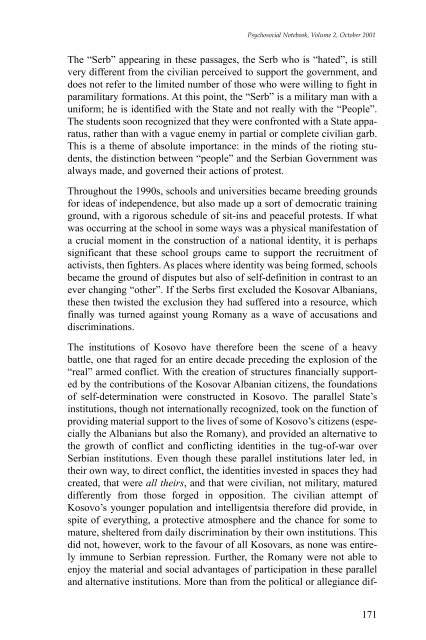Psychosocial Notebook - IOM Publications - International ...
Psychosocial Notebook - IOM Publications - International ...
Psychosocial Notebook - IOM Publications - International ...
Create successful ePaper yourself
Turn your PDF publications into a flip-book with our unique Google optimized e-Paper software.
<strong>Psychosocial</strong> <strong>Notebook</strong>, Volume 2, October 2001<br />
The “Serb” appearing in these passages, the Serb who is “hated”, is still<br />
very different from the civilian perceived to support the government, and<br />
does not refer to the limited number of those who were willing to fight in<br />
paramilitary formations. At this point, the “Serb” is a military man with a<br />
uniform; he is identified with the State and not really with the “People”.<br />
The students soon recognized that they were confronted with a State apparatus,<br />
rather than with a vague enemy in partial or complete civilian garb.<br />
This is a theme of absolute importance: in the minds of the rioting students,<br />
the distinction between “people” and the Serbian Government was<br />
always made, and governed their actions of protest.<br />
Throughout the 1990s, schools and universities became breeding grounds<br />
for ideas of independence, but also made up a sort of democratic training<br />
ground, with a rigorous schedule of sit-ins and peaceful protests. If what<br />
was occurring at the school in some ways was a physical manifestation of<br />
a crucial moment in the construction of a national identity, it is perhaps<br />
significant that these school groups came to support the recruitment of<br />
activists, then fighters. As places where identity was being formed, schools<br />
became the ground of disputes but also of self-definition in contrast to an<br />
ever changing “other”. If the Serbs first excluded the Kosovar Albanians,<br />
these then twisted the exclusion they had suffered into a resource, which<br />
finally was turned against young Romany as a wave of accusations and<br />
discriminations.<br />
The institutions of Kosovo have therefore been the scene of a heavy<br />
battle, one that raged for an entire decade preceding the explosion of the<br />
“real” armed conflict. With the creation of structures financially supported<br />
by the contributions of the Kosovar Albanian citizens, the foundations<br />
of self-determination were constructed in Kosovo. The parallel State’s<br />
institutions, though not internationally recognized, took on the function of<br />
providing material support to the lives of some of Kosovo’s citizens (especially<br />
the Albanians but also the Romany), and provided an alternative to<br />
the growth of conflict and conflicting identities in the tug-of-war over<br />
Serbian institutions. Even though these parallel institutions later led, in<br />
their own way, to direct conflict, the identities invested in spaces they had<br />
created, that were all theirs, and that were civilian, not military, matured<br />
differently from those forged in opposition. The civilian attempt of<br />
Kosovo’s younger population and intelligentsia therefore did provide, in<br />
spite of everything, a protective atmosphere and the chance for some to<br />
mature, sheltered from daily discrimination by their own institutions. This<br />
did not, however, work to the favour of all Kosovars, as none was entirely<br />
immune to Serbian repression. Further, the Romany were not able to<br />
enjoy the material and social advantages of participation in these parallel<br />
and alternative institutions. More than from the political or allegiance dif-<br />
171

















